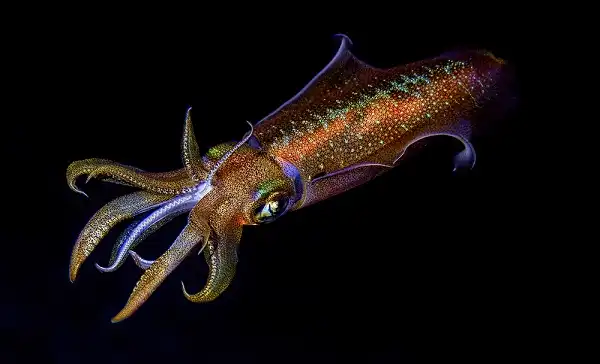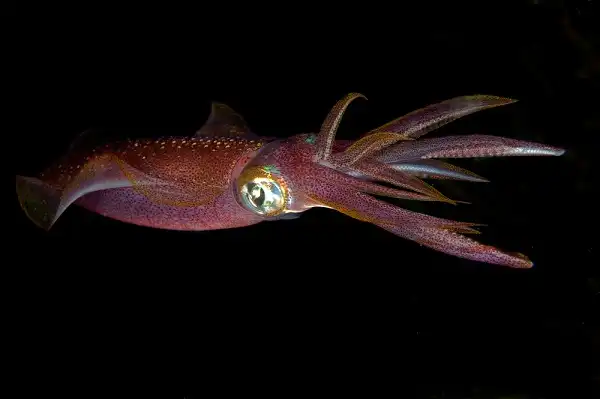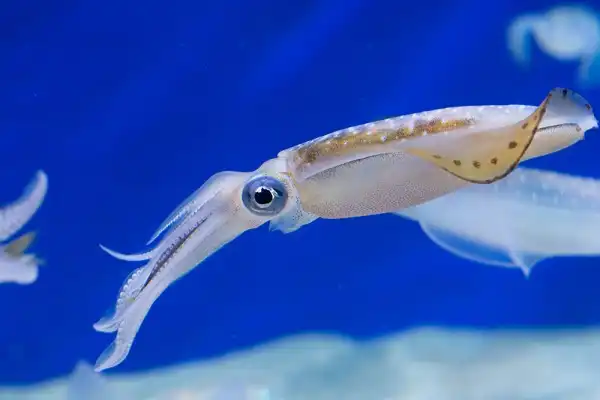Have you ever wondered what it’s like to live in the ocean depths as a squid? Do tales of their unique behaviors and physical traits fascinate you? If so, then keep reading! In this blog post, we will explore some fascinating facts about squid and how they have adapted to life deep under the sea. From their predatory capabilities to incredible anatomy, dive into a world of discovery with us – learning about these mysterious creatures ensures that your next deep-sea adventure won’t be forgotten!

Squid Description
Squids are cephalopod mollusks – a classification of marine creatures that have bilateral symmetry and a distinct head, arms, and mantle. They have eight arms and two tentacles for movement and prey capture. Squids are renowned for their advanced vision capabilities, with some species boasting up to 20,000 lenses in each eye! Squids also possess unique physical features such as an ink sac full of dark pigment they use to camouflage themselves or ward off predators. In addition, they have a fleshy “fin” on the mantle which helps them adjust their speed while swimming. Other adaptations include chromatophores in their skin that allow them to change color quickly when hunting or avoiding predators. The tentacles of squid are lined with suckers that assist in capturing food or defending against threats.
Squid Habitat
Squids can be found inhabiting the deepest parts of the world’s oceans, often living in depths ranging from 3,000 to 6,000 feet below the surface. They prefer cold temperatures and lack of light and often use their chromatophores to blend into their dark surroundings. Primarily nocturnal creatures, squid may emerge near the surface during daylight hours in search of food or to communicate with other squid. Their habitats are highly structured; depending on the species they inhabit different types of environments such as rocky reefs, sandy surfaces, dense vegetation, or muddy seafloors.
Squids will move between these areas for feeding and mating purposes and are often found in large groups. By living near each other they are able to take advantage of collective defense strategies, using their ink sacs to confuse predators or escape capture. Squids are also known to populate underwater mountain ranges such as seamounts and hydrothermal vents located miles beneath the sea’s surface. These unique environments are rich with nutrients and provide a safe refuge from predators. These conditions make them ideal habitats for squid which can be seen hovering around vents or playing amongst coral walls at twilight hours when it is too dark to detect them visually by sight alone!
Squid Diet
Squids have an incredibly varied diet, which is essential for their survival in the depths of the ocean. Squid feed on a wide range of prey including small fish, crustaceans, and mollusks. Many squid species hunt using specialized techniques such as jet propulsion or use lures to attract prey to them. They also possess sharp beaks that are used to tear apart each meal before consuming it. Some species have even evolved to utilize bioluminescence in order to lure unsuspecting food toward them! Squids will also feed on decaying organic matter such as plankton and detritus, which helps sustain their population at the bottom of the ocean. They are not picky eaters and can quickly adapt their diets when necessary, allowing them to survive in a wide variety of ecosystems. This ability allows them to exist in environments where other life forms would struggle due to a lack of food sources or extreme pressure and temperature changes.

Squid Size
Squids are incredibly diverse creatures that come in a variety of sizes. Some species can grow to be as small as 3 inches long, while others can reach up to 4 feet in length. The Giant Squid is the largest known species, with specimens measuring up to 36 feet long! Generally speaking, squid tends to be more slender and streamlined than their cephalopod relatives such as octopus and cuttlefish. This allows them to move quickly through the water in search of prey or evade predators. Squids also have a unique body structure which helps them adjust their buoyancy in order to conserve energy while swimming. This means that they can stay at any depth for an extended period of time without having to constantly swim up and down. The size of a squid’s mantle also affects its ability to maintain a certain depth; larger mantles are able to store more gas which is necessary for buoyancy control.
Squid Lifespan
The lifespan of a squid can vary greatly depending on the species and environment they inhabit. Smaller squid, such as Loligo vulgaris, may only live for up to 2 years while larger species like the Giant Squid can live up to 5 years. Generally speaking, squid tend to have shorter lifespans due to their high metabolic rate which requires them to consume a large amount of food in order to survive. Squids also face numerous threats from predators, environmental changes, and human activities which can reduce their life expectancy even further. In addition, some species are vulnerable to disease or parasites which can take a toll on their health and lifespan if left untreated. Overall, the precise lifespan of any given species of squid is difficult to predict as it depends greatly on the environment they inhabit and how they interact with their environment. However, what is certain is that these fascinating creatures have an incredible ability to survive and thrive despite facing innumerable obstacles!
Squid Behavior
Squid behavior is an incredibly fascinating topic that has been extensively studied in the past few decades. Squids are highly-intelligent creatures that have evolved unique ways of communicating, hunting, and avoiding predators. One of the most remarkable traits of squid is their ability to camouflage themselves using specialized cells known as chromatophores. These cells can rapidly expand or contract, allowing the squid to change their color and texture in order to blend into their surroundings. This enables them to hide from potential predators or sneak up on unsuspecting prey. Squids also possess a range of sensory organs that help them navigate the depths of the ocean. Most species have two large eyes which allow them to detect light levels and movement, while others may also have additional photoreceptors located on their tentacles which give them a 360-degree field of view underwater! In addition, squid rely heavily on their sense of touch when it comes to hunting. They possess eight suckered arms and two longer tentacles which allow them to grasp food in a similar fashion as human hands would do so on dry land! These tactile organs can also be used for communication with other squid, making them incredibly social animals as well as efficient hunters.

Squid Speed
Squids are capable of astonishing speeds in the water, and their speed can vary depending on the species. Smaller squid such as the Loligo pealei typically swims at speeds of up to 5 knots (5.75 mph), while larger species like the Giant Squid can reach upwards of 10 knots (11.5 mph). This impressive velocity is due to a combination of factors including their streamlined body shape, powerful fins, and specialized muscles which allow them to move with tremendous agility in the water. In addition, many squids utilize a technique known as jet propulsion which involves forcibly expelling water from their mantle cavity in order to propel themselves forward at high speeds! Squids also have some unique advantages when it comes to swimming; they possess two rows of suckers on each tentacle which can grip onto objects or surfaces in order to help them maneuver quickly through tight spaces.
Squid Hunting
Squid hunting is an incredible feat of adaptation and skill, as these slippery creatures possess many tools at their disposal to track down their prey. Squids rely on various senses in order to effectively hunt in the ocean; they have two large eyes which allow them to detect movement and changes in light levels and can also use photoreceptors located on their tentacles for a 360-degree field of view. Furthermore, squid possess eight suckered arms and two longer tentacles which enable them to grasp food in a similar fashion as human hands would do so on dry land. Squids are also highly adept predators thanks to their ability to camouflage themselves using specialized cells known as chromatophores. This enables them to blend into their surroundings, allowing them to sneak up on unsuspecting prey without alerting nearby predators or drawing attention from potential competitors. In addition, squid have developed unique ways of tracking down prey; some species employ chemical lures such as bioluminescence or hydrocarbons in order to attract meals while others use sound waves or electrical discharges to detect potential food sources.
Squid Life Cycle
Squid begin their life cycle as tiny, transparent eggs which are released into the ocean by either parent during spawning events. These eggs are typically laid in clusters or spiral formations and can remain dormant for extended periods of time until they hatch. Once hatched, the newly born squid larvae will make their way to the surface of the water in search of food. The larval stage of a squid’s life is a critical time for development and growth; it is during this period that they will gain size and strength while also developing various physical features such as eyes, tentacles, and an ink sac. As they mature, these larvae will eventually become juvenile squid before transitioning into adults. Adult squid typically reaches sexual maturity after 1-2 years, at which point they will enter a breeding season where males compete with one another for potential mates while females search for genetic compatibility among potential suitors. After a mate is chosen, they will join together in a synchronized dance before releasing sperm and eggs into the water – where future generations will develop!

Conclusion
Squids are remarkable creatures who have adapted to life in the ocean over millions of years. They possess impressive speed, agility, and hunting skills, as well as a variety of other special abilities that allow them to survive in their deep-sea environment. From jet propulsion and chromatophores to powerful suction cups and bioluminescence – squid has developed some amazing tools and techniques for finding food or avoiding predators. We are only just beginning to understand these mysterious creatures, but with further research, who knows what else we might discover about their behavior in the depths of our oceans? With careful preservation and conservation efforts, hopefully, we can ensure that future generations get to experience these fascinating animals for years to come!
Frequently Asked Question


